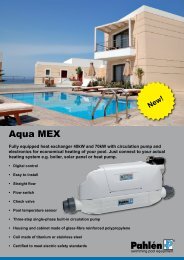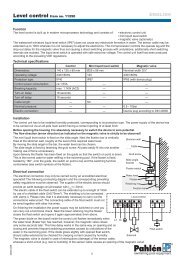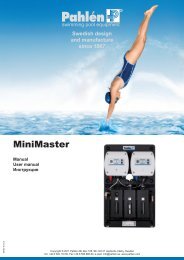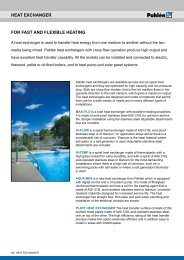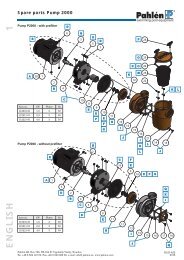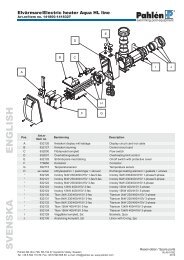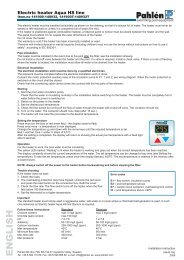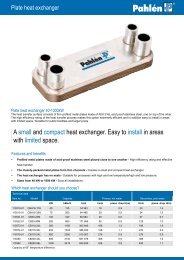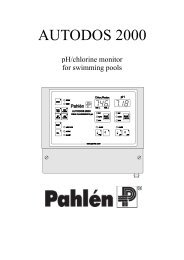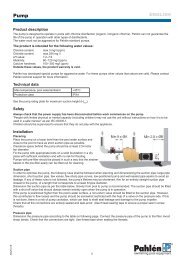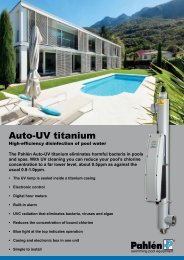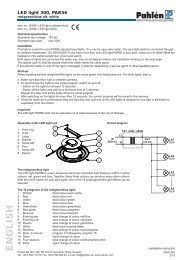Create successful ePaper yourself
Turn your PDF publications into a flip-book with our unique Google optimized e-Paper software.
<strong>User´s</strong> <strong>guide</strong>www.pahlen.com
Pahlén ABPahlén is a genuine Swedish company with more than 40 years experience of manufacturing quality products forswimming pools. Our main selection consists of five product groups: Heating equipment, pumps, Jet Swim, stainlesssteel pool equipment and measuring and dosing equipment.Ever since the company was founded in 1967 the business has been focused on developing and manufacturingswimming pool equipment. Our range includes today equipment for every type of pool, from small private pools tolarge public baths.The Pahlén products are made of bronze and acid-proof stainless steel, high quality materials, that guaranteereliability and a long life. They are manufactured in our factory in Upplands Väsby, where they are alsocarefully checked of quality before delivered to our customers.Approximately 70% of the total production is exported to more than 70 countries and our products are to be found ininstallations all over the world. Among the delivered pool projects are all types of swimming pools, e.g. competitionpools, hotel pools, adventure baths, luxury private pools, pools inroyal houses in several countries and of course pools in privatehouse gardens.Our distributors have long experience of pools and are ableto help you with everything from the planning to the finishedswimming pool.For more information visit us onwww.pahlen.com
High quality products from PahlénA well-maintained pool with clean, clear, sparkling water promises many enjoyable moments, as well as a refreshingdip in the morning or an evening swim in the glow of the pool lights. Your pool will come to be the place where yourfamily and friends naturally congregate.We have produced this <strong>guide</strong> for you, the pool owner.It explains how a pool works and how you look after itto get the greatest possible enjoyment from your poolinstallation.Many people think that having a pool involves a lot ofwork, but if you look after the circulation system andtake care of the chemical cleaning as described in this<strong>guide</strong> you can look forward to many pleasant swims ina pool of clean, clear water with very little trouble.A long-term investment with quality products from PahlénWhen you decide to invest in a swimming pool you should also decide to invest in quality equipment. Our Swedishmade quality products in acid-proof stainless steel, titanium and bronze stand for quality.The water flow must always work. Skimmers andinlets in acid-proof stainless steel and bronze.Swimming for exercise will be more fun andeffective with Pahlén Jet Swim in the pool.Acid-proof stainless steel and bronze.The water must be clean and clear. The sand filterand the pump is the heart of the pool. Pump andcentral valve made of bronze. Tank made ofglass-fibre reinforced plastic.Underwater lights in acid-proof stainless steel will lastfor many years without problems.A heated pool will extend your pool season. Pahlén heating equipment is well known all over the world and are todayin all types of small and large swimming pool installations. The heating products are manufactured from acid-proofstainless steel, titanium or plastic for an optimum length of life.Pahlén electric heaters are available in sizes from 1,5kW to 72 kW.Pahlén heat exchangers are available in sizes from 13kW to 308kW.
Installation examplesWith heat exchangerThere are many different models ofthe Pahlén heat exchangers.SkimmerInletThey are made of acid-proofstainless steel, titanium or plasticand are available in sizes from13 to 308kW.LightMain drainThermostatJet SwimLightThe example shows the installationof the heat exchanger Maxi-Flo.PumpFilterHeatexchangerCirculationpumpBoilerDrainWith electric heaterThe Pahlén electric heaters areavailable in many models withdifferent combinations of safetyequipment.SkimmerLightJet SwimLightInletThey are made of acid-proofstainless steel, titanium or plasticand are available in sizes from1,5 to 72kW.Main drainFilterFlowswitchThe example shows the installationof an electric heater compact.PumpDrainElectric heaterWith heat pumpPahlén digital heat pumpMaxitemp is available in three sizeswith outputs from 5,4 to 17kW.Inlet800Skimmer>400The body is made of stainlesssteel and the condensor, the heatexchanger of the pool, is made oftitanium.Heat pumpLightJet SwimLightMain drainThe heat pump is installed outdoorsand on the return pipe of the pool.FilterThe example shows the installationof a heat pump Maxitemp.DrainPump
StartCommissioning a newly-filled pool or starting in the spring1. When starting in the spring, re-install pool components removed for the winter, close drain valves and refitdrain plugs.2. Fill the pool until the water level is in the centre of the skimmer opening.3. Fill the filter basket housing on the pump with water. NOTE: Never start the pump without water as thismight damage the shaft seal.4. Open the valves of the suction, return and drain outlets.5. Turn the lever on the valve to BACKWASH.6. Start the pump. When the pump has evacuated the air out of the suction line (after about 1-3 minutes)and water is passing through the sight glass on the valve drain outlet, rinse for about 1-2 minutes or until thewater in the sight glass is clear. NOTE: Any electric heater must be off.7. Stop the pump.8. Turn the lever to RINSE, start the pump and rinse for about 15-30 seconds. Stop the pump and turn the leverto FILTER. This is the normal operating position.9. Close the drain outlet valve and start the pump. NOTE: Always stop the pump before moving the lever ofthe valve.10. Check the pH and adjust it to 7.2 to 7.6. Shock-chlorinate via the skimmer to a chlorine level of 2 ppm (mg/l).With repeated chlorine dosing, wait three hours between tests to give the chlorine time to dissolve. After 24hours, brush the bottom and sides of the pool clean and vacuum the bottom of the pool.Vacuum cleaningAttach the vacuum head to the telescopic handle and attach the vacuumhose to the vacuum head. Place the vacuum head on the bottom of thepool and feed the vacuum hose down under the surface of the wateruntil the hose is filled with water and emptied of air. Bring the otherend of the hose to the skimmer. Fix the Skimvac over the filter basketand connect the vacuum hose.If the suction at the vacuum head gets weaker, empty the skimmerfilter basket. If the pool is very dirty, you may also need to empty thefilter basket in the pump and backwash the filter. After finished vacuumcleaning, switch off the pump and disconnect the Skimvac from the filter basket.
Cleaning the filter sandAfter about 5-10 days, or when the reading of the pressure gauge on the pump side of the filter has increased by about0.2 bar (20 kPa, 3 psi) since the last backwash, backwash the filter as follows:1. Stop the pump.2. Close the valves on the suction and return lines.3. Open the cover of the pump and empty the filter basket.4. Refit the cover.5. Open the valve to the drain outlet.6. Turn the lever to BACKWASH.7. Open the valves to the suction and return lines.8. Start the pump. Rinse the filter for about 1 to 2 minutes or until the water in the sight glass is clear.NOTE: Any electric heater must be off.9. Stop the pump.10. Turn the lever to RINSE, start the pump and rinse for about 15-30 seconds. Stop the pump and turnthe lever to FILTER. This is the normal operating position.11. Close the drain outlet valve and start the pump. Switch on the electric heater if any.Positions of the backwash valveFILTRATIONBACKWASHRINSEWASTECLOSEDCIRCULATIONNormal filtering position.Cleaning the filter sand.Stabilizing the filter sand.For vacuum cleaning the bottom of the pool directly to drain, or foremptying the pool.Closed.Pumping water directly to the pool (no filtering).
The circulation system of the poolSkimmerWater is removed from the pool via a skimmer which has a flap lid thatpositions itself according to the surface of the water. The skimmer increases theflow rate of the surface water and draws any debris on the water surface into theskimmer. The debris accumulates in a filter basket. The basket must beemptied regularly, about once a week. If your pool has a main drain, the flow mustbe regulated so that about 30% of the water is taken from the bottom and about70% from the skimmer.InletsThe cleaned and heated water is returned to the pool via the inlets. The inlets should bedirected slightly upwards to move debris towards the skimmer.PumpThe pump creates the suction in the skimmer and then forces the water through the filter, through the heater and backto the pool via the inlets. The filter basket in the prefilter of the pump must be emptiedregularly, for example when backwashing.Before starting the pump, make sure that it is full of water, otherwise the shaft seal ofthe pump may be damaged. If the pump is placed above the surface of the pool water,the water drains back to the pool when the pump is stopped. Then, when the pump isstarted, it may take some time for the pump to evacuate all the air in the suction line andstart pumping water. To overcome this close the valve ahead of the pump and thenimmediately switch off the pump. Doing this retains the water in the suction line.FilterThe pool water is cleaned mechanically by a sand filter which filters out particles down to about20 µ (microns, thousandths of a millimetre). On top of the filter tank there is a valve which controlsthe flow of water through the filter. The filter is two-thirds filled with filter sand with a grain size of0.6-0.8 mm. As more and more dirt is trapped in the filter, the back-pressure increases. It can beread off on the backwash valve pressure gauge.When the back-pressure has increased by about 0.2 bar since the last backwashing, the filtermust be backwashed again. This means reversing the flow through the filter so that the dirt isreleased from the sand and flushed out via the drain. The filter sand should be changedafter 6-8 years.HeatingAfter the filter, the pool water is heated to a pleasant temperature. The water can be heated with anelectric heater, by a heat exchanger connected to the domestic boiler, by solar panels or by a heat pump. Set thethermostat to the desired pool temperature.
Chemical cleaningThe pool water must be clear and totally free of both visible and invisible dirt. Visible dirt is mainly removed by the poolfilter. The invisible dirt is made up not only of bacteria, which can multiply very rapidly and cause problems, but alsoalgae and fungi of various kinds which spread to the pool, where they find the conditions pleasant. Chemical agentsare used to combat and control these.To make sure the water in the pool is crystal clear and clean, it needs to be chemically treated for:DisinfectionThe pool water is disinfected to kill organisms such as bacteria, algae and fungi. Pool chemicals “burn off” thecontaminants and make the water sparkling and fresh. The most widely used and effective agents are those thatcontain chlorine or bromine.pH adjustmentDisinfecting agents work at their best within a narrow range of pH. The watermust be neither too acid nor too basic. The ideal pH range for the pool and thehuman body is between 7.2 and 7.6.Combating algaeAnti-algals prevent the algae from getting established and multiplying in thepool. Algae that have already become established need to be removed with anextra-high dose of chlorine (shock chlorination). With regular chlorination, thereis normally no need for anti-algal treatment.Flock dosingIf the pool water is filtered well, smaller amounts of chemicals will be needed to keep the water clean and clear. Flockand clarifier cause the micro-dirt to form larger particles, which are trapped by the filter. Only pools with a sand filtercan be flocked.
Standard routines for good water careDaily chlorinationDaily chlorination is the most effective way of disinfecting the pool water. Calcium hypochlorite in small tabletsdissolves slowly and releases chlorine into the pool water. Place the tablets in the skimmer or in a floating dispenser.Shock chlorination is done with calcium hypochlorite but in granular form. The granules dissolve quickly to give the poolwater a rapid and powerful chlorine boost. Daily as well as shock chlorination raise the pH of the water. Use a pHloweringagent to balance the pH once a week and after every shock chlorination.Weekly chlorinationFor weekly chlorination use a product containing slow-acting trichlorisocyanuric acid. E.g. 200 gram tablets dissolveslowly and continuously disinfect the pool water. Normally one tablet is enough for 20 m 3 of water for one week.Place the tablet in a dispenser. Use the test kit to check the free chlorine. If the reading is below 1.0 ppm (mg/l) applyadditional chlorine.Weekly chlorination is recommended in areas with relatively hard water. It contains a chlorine stabilizing agent(cyanuric acid) but no lime, since there is a risk that this would further increase the calcium hardness and lead to limebeing precipitated in the pool. When using weekly chlorination, regular shock chlorination with calcium hypochlorite isrecommended. The chlorine for weekly use lowers the pH of the water. This can be balanced with shock chlorinationgranular.HalobromHalobrom is similar to the products for daily/weekly/shock chlorination in many respects, but it has the followingadvantages:a. Halobrom can be used alternately with or at the same time as the products for daily/weekly/shock chlorination.b. Halobrom retains its full disinfectant power within a significantly wider pH range than the chlorine products.c. The typical chemical smell is non-existent. Halobrom is recommended for therapy baths, whirlpool baths and forindividuals who are sensitive to chlorine.Halobrom tablets can be placed in the skimmer, in dispenser or a brominator, a special pressure vessel for continuousdosing of bromine solution to the pool water.The bromine demand depends entirely on how the pool is used. Dosing must take account of temperature and userfrequency. The bromine content must be measured regularly to check the consumption.
pH - ChlorinepHThe pH is a measure of the acidity of the water. The pH scale goes from 0 to 14, where pH 7 is neutral. If the pH isabove 7, the water is basic; if it is below 7 the water is acid. The optimum pH for pool water is 7.4, since this is thesame as the pH in human eyes and mucous membranes. A pH of 7.4 also gives good chlorine disinfection.A low pH gives:- aggressive water, which damages the mechanical components of the pool- irritations of the eyes and mucous membranes- damage to the pool linerA high pH gives:- poorer chlorine disinfection- skin irritation- lime precipitation- cloudinessThe <strong>guide</strong>line pH figure is 7.2 – 7.6.To lower the pH, use sodium bisulphate; to raise it use sodium carbonate.Chlorine effect in relation to pH-value.Chlorine 100%pHChlorineChlorine compounds may provide organic or inorganic chlorine. Organic chlorine is trichlorisocyanuric acid (for weeklychlorination) and dichlorisocyanuric acid (dissolves rapidly and is suitable for small pools).Inorganic chlorine is calcium hypochlorite (for daily and shock chlorination) and sodium hypochlorite (liquid).When a pool is dosed with either organic or inorganic chlorine it is free chlorine that attacks bacteria andcontaminants. As the chlorine acts it is converted into combined chlorine. Combined chlorine (also known aschloramines) is ineffective, smells of chlorine and may cause irritation of the eyes and mucous membranes. To reducethe combined chlorine, the pool is shock chlorinated with calcium hypochlorite. The high chlorine content that formstemporarily on shock chlorination disappears quite quickly in an outdoor pool, but can also be lowered with chlorinereduction compounds. Chlorine is continuously consumed in the pool, and different factors determine the chlorineconsumption, including bathing frequency, water temperature, sunlight and pool size. A test kit is used to measure thechlorine content. Most kits measure free chlorine, but to measure the combined chlorine you need to measure totalchlorine. Total chlorine is the sum of free and combined chlorine.If organic chlorine (weekly chlorination) is used, cyanuric acid accumulates in the pool. Where the cyanuric acid contentis above 100 ppm (mg/l), chlorine blocking may occur, making the chlorine ineffective. Cyanuric acid can be removedby adding water from the mains supply.Cyanuric acid acts as a chlorine stabilizer, preventing the sunlight from breaking down the chlorine, for example.It is therefore advisable for outdoor pools to have a cyanuric acid level of 10-20 ppm (mg/l).Guideline values:Free chlorine: 0.5-1.5 ppm (mg/l)Combined chlorine: 0-0.5 ppm (mg/l)Total chlorine: 0.5-1.5 ppm (mg/l)Cyanuric acid: 0-50 ppm (mg/l)
Total alkalinity - Calcium hardnessTotal alkalinity (TA)Total alkalinity is a measure of the amount of alkaline substances in the water. These may cause the pH of the water tochange in an uncontrolled manner. A low TA makes the water aggressive and causes rapid pH fluctuations. A high TAmakes the pH difficult to adjust and causes cloudiness and lime precipitation. The <strong>guide</strong>line figure when using calciumhypochlorite (daily or shock chlorination) is 60-100 ppm (mg/l) and with trichlorisocyanuric acid (weekly chlorination)and Halobrom 90-125 ppm (mg/l).Total alkalinity can be reduced with sodium bisulphate and increased with sodium bicarbonate.Calcium hardness (CH)The calcium hardness is a measure of the amount of lime dissolved in the water. Water with a CH of less than100 ppm (mg/l) is described as soft water and draws lime out of, for example, the concrete of cast pools and tilegrouting, leading to disintegration. It also makes the water aggressive.Water with a CH above 300 ppm (mg/l) is described as hard water and causes lime to be precipitated. Limeprecipitation causes limescale to form on the walls and pipes of the pool and in its mechanical equipment.The <strong>guide</strong>line figure is 100-300 ppm (mg/l).The calcium hardness can be reduced by dilution with fresh mains water and increased with calcium chloride.
Balanced waterThe balance of the pool water is determined on the basis of simultaneous measurement of temperature, pH, calciumhardness and total alkalinity. Calculation of the water balance gives an idea of whether the pool water is aggressive orwhether it will cause limescale deposits.An index value above +0.5 givesAn index value below -0.5 gives- lime-precipitating water.- cloudy water and limescale deposits on the walls, pipes etc of the pool.- aggressive water.- irritation of the eyes and mucous membranes, as well as attacking the mechanicalequipment of the pool.The index value is calculated with this formula:Index value = pH+TF+CF+AF-12.1pH pHTF Temperature FactorCF Calcium hardness FactorAF Total alkalinity Factor12,1 A constantSee the table below for the factor for each parameter in the formula.We recommend the Autocheck II photometric test kit for determining the water balance. This is in order to obtain anexact value for each parameter in the formula.Temp°CTFCalciumhardnessmg/l CaCO 3CFTotal alkalinitymg/l CaCO 3AF20 0,52 25 1,00 25 1,4022 0,56 50 1,30 50 1,7024 0,6 100 1,60 70 1,8625 0,62 120 1,68 80 1,9226 0,64 140 1,76 90 1,9627 0,66 150 1,80 100 2,0028 0,68 170 1,84 120 2,0830 0,72 200 1,90 150 2,2032 0,76 250 2,00 200 2,3034 0,8 300 2,10 300 2,5041 0,9 400 2,20 400 2,60
Test kitA test kit is used to check the free chlorine and pH of the pool water. Some test kits also measure total chlorine, totalalkalinity, calcium hardness and cyanuric acid. The DPD test kit is available in a manual version, in which the test wateris compared with a colour scale, and a photometric version, in which the value is displayed digitally to two decimalplaces. Every test kit is supplied with test tablets as follows:DPD no. 1 measures free chlorineDPD no. 3 measures total chlorinePhenol red measures pHWhere the chlorine level is above 5 ppm (mg/l) the test water is bleached. The result may then indicate that there is nochlorine in the pool. If you suspect this, you can dilute the test water with ordinary tap water.Avoid touching the test tablets with your fingers as this may cause incorrect results.Test strips are dipped in the pool and their colour of the measurement areas is compared with the colour scale on thepack. For correct readings, move the test strip back and forth in the water for five seconds. Take thestrip out of the water and wait five seconds before comparing the colours.
Problems and solutionsSymptom Cause ActionEye and skin irritationRed eyes Incorrect pH Adjust the pHSkin irritationHigh combined chlorine:(not enough free chlorine)Shock chlorinate with calcium hypochloritesmall tablets or chlorine granulesLimescale depositsLimescale on walls, pipes,filters and electric heaterspH too highCalcium hardness too highTotal alkalinity too highAdjust with pH lowering agentDetermine water balance and adjustHigh chlorine levelHair and swimsuites Too much chlorineAdd chlorine reducing agentare bleachedPossible eye irritation Incorrect test readings Check the test equipmentAlgaeGreen algae, green water,slippery surfaces, cloudywaterSpots of black algaeNot enough chlorineAdjust the pH and shock chlorinateAdjust the pH, scrub the surfaces with chlorinesolutionAdd anti-algal agentHigh chlorine consumptionUnusually high consumptionof disinfectionpreparationsLarge numbers of bathersSevere contaminationHigh air and water temperatureNot enough stabilizing agent in thepoolShock chlorinate with calcium hypochloriteAdd cyanuric acidCloudy waterCloudy water Signs of algae formation Shock chlorinate with calcium hypochloritePoor filteringCheck the filterpH too highAdjust with pH lowering agentGreen waterGreen water Algae Shock chlorinate with calcium hypochloriteCopper corrosion (pH too low) Increase the pH with pH-increasing agentDiscoloured waterBrown Iron 1. Adjust the pHBlack Manganese 2. Shock chlorinate with calcium hypochloriteBlue-green Copper 3. Flock the pool water with flocking agent
Closing down for the winterWhen the bathing season is over and winter is coming on, you need to check your pool and its equipment. Preciselywhen to do this depends partly on where the pool is geographically and partly on the way the pool is used. Below sometips on what to do when the bathing season is over. Check whether the structure of your pool can withstand the waterfreezing. Under certain circumstances the surface of the water must be insulated and circulation must be maintained.For pools that can withstand freezing:ABAdjust the pH to 7.2-7.6 and switch off the pool heating.Allow the pump to circulate the pool water and continue withreduced chlorination until the temperature of the pool water fallsbelow +7 °C. The final shutdown procedure is as follows:The final shutdown procedure is as follows:1. Brush down the sides of the pool and vacuum the pool thoroughly to make sure that it is really clean.2. Backwash the filter thoroughly for 3 to 5 minutes. Then set the backwash valve lever to FILTER.3. Switch off the electric power at the mains (fuse box).4. If there is a pool ladder, take it out, wipe it off and store it in a dry place.5. Remove the filter basket and flap lid from the skimmer. Then install an expansion flask or pieces of cellularplastic where the filter basket was located. These will take up the expansion of ice.6. Remove the adjustable inlet nozzles (the balls). If the pump/filter unit is below the water level,install winter plugs where the inlet nozzles were removed.7. Remove the lighting unit and store it in a plastic bag on the edge of the pool.8. Drain the filter tank by unscrewing the drain plug in the bottom of the tank.9. Remove the pump cover and take out the filter basket. Remove the drain plugs from the pump housing and thepre-filter housing. If the pump is outdoors, the motor should be removed and stored indoors.10. Remove the pressure gauge on the backwash valve of the filter.11. If the heater is not in a frost-free location, remove the drain plug. If there is no drain plug, disconnect the pipecoupling between filter and heater, so that all water is drained from the heater.12. Add anti-algal agent as recommended on the pack.13. Shock-chlorinate by dissolving calcium hypochlorite in a bucket of warm water and tipping it into the pool.14. If the pool has steps, provide something around the steps to take up expansion which will shrink when the icemoves, reducing any strain on the steps. This could be a few plastic containers partly filled with a mixture ofwater and antifreeze (glycol), held in place with a weight.15. Place your pool cover over the pool.
Pahlén ABBox 728, SE-194 27 Upplands Väsby, SwedenTel. +46 8 594 110 50, Fax +46 8 590 868 80e-mail: info@pahlen.se, www.pahlen.comMiddle East Branch OfficePahlén AB, Executive suite L1-41, P.O. Box 121888SAIF Zone, Sharjah, United Arab EmiratesTel : + 971 6 557 05 95, Fax: + 971 6 5570599e-mail: anil.prabhakaran@pahlen.seDistributor:Item no. 99985031 2009-05-19 © Pahlén AB 2009www.pahlen.com



